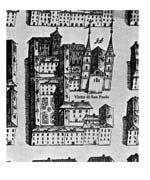Per una storia della Compagnia di San Paolo (1563-1853) – Vol. II
edited by W. Crivellin and B. Signorelli
The opening essay, by Laura De Fanti, is given over to the choices made and trends pursued for setting up the Compagnia di San Paolo’s art heritage. What emerges is the constant support for the building and embellishment of the church of the Santi Martiri, especially for the Chapel of St. Paul, with the painting by Federico Zuccari. The church, thanks to Compagnia’s tie with the Jesuits, was built in the Isola di San Paolo (District of St. Paul), next to the Monte di pietà (Pawnbroker’s) and the Oratory of St. Paul. It was here that over time the picture gallery, started with the work of Alessandro Ardente depicting The Fall of St. Paul and continued with the major works directed by Emanuele Tesauro. The cycle consists of a series of paintings depicting events in the apostle’s life, the work of painters such as Caravoglia, Sacchetti, Dauphin and Andrea Pozzo.
In La costruzione della nuova sede della Compagnia di San Paolo nell’isolato San Felice (1701-1704) Bruno Signorelli analyses the transfer of the Compagnia’s Headquarters from the Isolato di San Paolo, decided upon at the end of the seventeenth century to provide the brethren, who were constantly increasing in number, with a larger Oratory as well as creating new premises for the Monte di pietà. Through a complex financial and real estate transaction, by the sale to the Jesuit fathers of the area belonging to the brethren and by opening a series of loans the Compagnia bought palazzo Nicolis di Robilant. The analysis of the Compagnia’s accounts allows one to identify the architects and the master masons who restyled the new headquarters. Furthermore the author highlights the external and internal financial relationships of the Opera del deposito, Casa del soccorso, Ufficio pio and Monte di pietà. The essay comes complete with the documentation on the 1705 census, master masons’ contracts and Compagnia statements of accounts.
Andrea Merlotti’s study La Compagnia di San Paolo alla metà del XVIII secolo. Una élite politico-economico tra corte e municipalità examines the relationships between officers of the Compagnia and the two protagonists of the Ancien Regime, court and city authorities. Through the use of cross-referenced sources, and above all the membership lists of the confraternity, the essay highlights the role played by the Compagnia as a power centre able to condition the activity of the city authorities in Turin, while remaining substantially independent. As in the seventeenth century, also during the reign of Charles Emanuel III many officers of the Compagnia held important offices in the Savoyard administration and in the City Hall, where vice-versa many officials (decurioni) – around half in 1730 – were members of the Compagnia. Among the profiles of several personalities, that of Francesco Giacinto Gabaleone di Salmor, is emblematic, he was rector of the Compagnia, mayor of Turin, head of the Council of Commerce, governor of the Royal Academy, reformer of the University and protector of the Collegio delle Provincie. Numerically less was the percentage of clergy who were members of the confraternity, but considering their careers the author hypothesises that taking out membership of the Compagnia was a stepping stone to access to the court and a bishopric appointment, as in the case of abbot Michele Vittorio De Villa, appointed, after entering the Compagnia, vicar general and royal almoner.
Per una storia della Compagnia di San Paolo (1563-1853),
edited by W. Crivellin and B. Signorelli, vol. II, Torino, 2005




